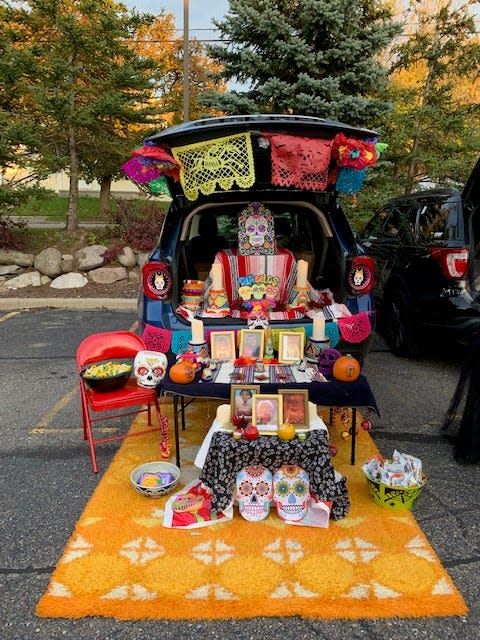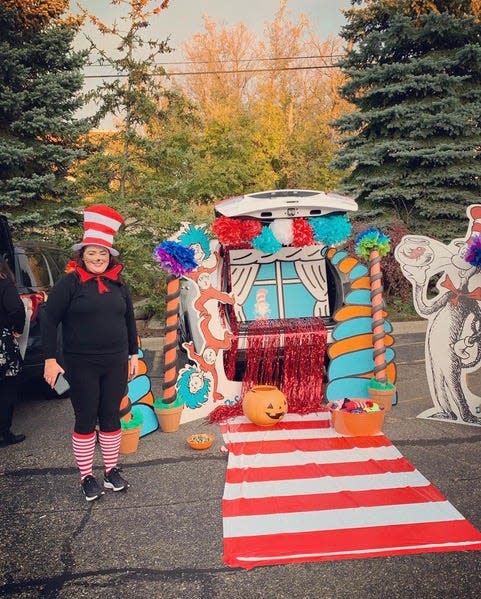Trunk-or-treat: Taking a look at the alternative Halloween trend
Have you ever gone trick-or-treating in a parking lot?
The activity is called “trunk-or-treat,” and it has firmly taken hold among Michigan’s Halloween celebrations.

Alternatives to traditional neighborhood trick-or-treat have existed for decades in the form of a costume parade, a pet parade, a street party, a “harvest festival,” “downtown trick-or-treat,” candy stations along a trail, or “indoor trick-or-treat.” A common theme is that the organizers wish to provide a safe Halloween activity for families with young children, as compared to walking in a perhaps unfamiliar neighborhood after dark.
But a “trunk-or-treat” stands out among the alternative genre – with a phrase that explains exactly what to expect: lots of treats, handed out from decorated trunks of parked vehicles.
The origins of the phrase have been lost, but the trend can be tracked.
One of the first national articles about trunk or treat was a 2006 New York Times article that described the scene as “Halloween tailgating.” It mentioned some California communities had been doing it since the mid-1990s and that year it was the latest trend in suburban New York state.
That’s around the time trunk-or-treat emerged in Michigan. One of the first ones in southern Wayne County took place during 2004 in Trenton, hosted by a church in their parking lot. There were 700 people attending that inaugural event, and by 2008, attendance jumped to over 7,000.
By 2015, trunk-or-treat events were taking place all over the state in communities such as Sturgis, Holland, Lansing, Petoskey and Gaylord. Car decorating kits intended for trunk-or-treat were available in retail stores. Pinterest was by then – and remains - a popular search site for do-it-yourself costume and trunk ideas.
Trunk-or-treat also was seen as an option for outdoor Halloween fun during the height of the pandemic, as the Free Press reported in 2020.
Despite recurring questions, trunk-or-treat hasn’t replaced the tradition of neighborhood trick-or-treat. Many of Michigan’s trunk-or-treat events are scheduled on a different date of when their community’s trick-or-treat takes place; others became part of already-existing fall events.

As with other Halloween activities, you can find trunk-or-treat announcements in your local newspaper, perhaps in a church bulletin or a flier from school, or among Facebook community event listings.
Are you looking to host your very own trunk-or-treat? Here are some event planning suggestions:
Decide how to handle candy supplies. Some organizers seek sponsors for candy, some ask car hosts to supply candy, some request each family bring a bag of wrapped candy as admission fee, and some charge admission to cover the cost of treats purchased ahead of time.
Decide when to hold the event. Trunk-or-treats in Michigan usually take place during the last two weeks of October, but not usually on the community’s trick or treat night.
Announce the event. Start planning and publicity a few weeks in advance, especially if you are asking for sponsors or candy hosts. Send notices to the local newspaper, get fliers posted at community bulletin boards, include information in school or church announcements, set up a Facebook “event” page for participants to get reminders.
Decide on an “inclement weather” plan. Michigan weather can be unpredictable during October.
Provide instructions on theme or costume requests. Some churches ask for outfits with Bible themes or portraying saints; some organizers request “no scary costumes.”
Consider allergy-friendly treats. A mix of candy options and party favors will be welcomed by families whose children are allergic to nuts or common candy ingredients.
If you're planning on attending a trunk-or-treat, here's what you should know:
Look over the announcement details. Many trunk or treat events are aimed at young families or hosted by organizations that wish to provide a “fun alterative” to scary Halloween activities. If a particular event doesn’t fit with how you’d like to celebrate the season, there’s likely to be another one that does.
Bring a candy bag or tote for each child. The intent is to collect candy and party favors – so bring a plastic pumpkin, tote bag or pillow case to hold all the treats!
Paula Wethington is a digital producer for the USA Today network’s Michigan newspapers.
This article originally appeared on Detroit Free Press: Trunk-or-treat: How the trend began in Michigan
